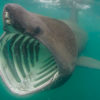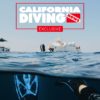Little Farnsworth can be a challenging dive. The first time we tried to dive it, my buddy and I missed the pinnacle, as the boat had slipped anchor and a rather strong current pushed us off the site. A few months later we were more fortunate.
Descending to the rock face with my lights on, I met a wall of “sunshine” — an orange-yellow burst of zoanthid anemones. In parts they covered everything — rock, gorgonians, everything. Healthy stands of red and gold gorgonian provided pops of accent color.
Little Farnsworth gets its name from the more spectacular offshore pinnacle on the backside of the island, Farnsworth Bank. On many charts the site appears as Pinnacle Rock, but most divers call it Little Farnsworth. While not as stunning, this smaller reef is more protected from open ocean conditions and is divable more days out of the year. Even so, this is an advanced dive. The rock peaks out at 60 feet but drops off rapidly on all sides. Average dive depths here are in the 80- to 100-foot range, with 130 feet easily possible. Currents are common and sometimes quite strong. This is a popular fishing spot, so fishing line and hooks are abundant. Be sure to carry a dive knife, line cutter or shears in case you get tangled.
The diving area is rather small and can be covered in one dive. Just be sure to keep an eye on your depth and pressure gauges. The main pinnacle is divided from a secondary spire inshore by a huge gash. It’s not quite large enough for a diver to pass through but is a perfect hideout for various fish species, and lobster. Gorgonians thrive here, feeding on nutrient-rich water carried in the current. A boulder has fallen into the gash, forming an archway of sorts. All of this is decorated with gorgonians and zoanthid anemones. Garibaldi and sheephead move in and out of the opening. It’s an excellent place for wide angle and macro photography.
Giant sea bass roam here, too. Whether you see them depends more on luck than anything, but your best chances are in late spring through summer. Some seem to be as big as a small cow. It’s quite a sight to watch the massive wall of fish flesh pass before your eyes. Photographers will want to use a wide-angle lens to fit a sea bass in the frame. For the best encounter, stay still and let them cruise past you; do not chase them or try to touch them or they’ll spook and dart off. They like to hang out around the thermocline where the varying water temperatures seem to please them. Thermoclines at this site swirl due to the currents and diversity of depths along the rock pinnacles.
There are other, smaller rock pinnacles surrounding the main spire. Out and to the west is a deeper rock coming up from a 130-foot bottom. Inshore from the secondary spire is another rising from a 90-foot bottom. Visibility is good here, 40 to 60 feet, so circumnavigating the main and secondary spire you can usually see all these smaller rocks.
Finding the site is easy but requires a depth finder as there is rarely kelp; what little kelp might be present is usually laid over in the current. The pinnacle is about 150 yards offshore from a rock mountain onshore between two green tanks at the far end of Pebbly Beach and the trash incinerator plant on the bluff. Using GPS and a depth finder, it is easy to find as the bottom rises suddenly from 100/130 to 60 feet.
This is a stunning dive. Stunning for its topography, stunning for its color, and stunning for its potential of encounters with big sea bass and other open water visitors.






